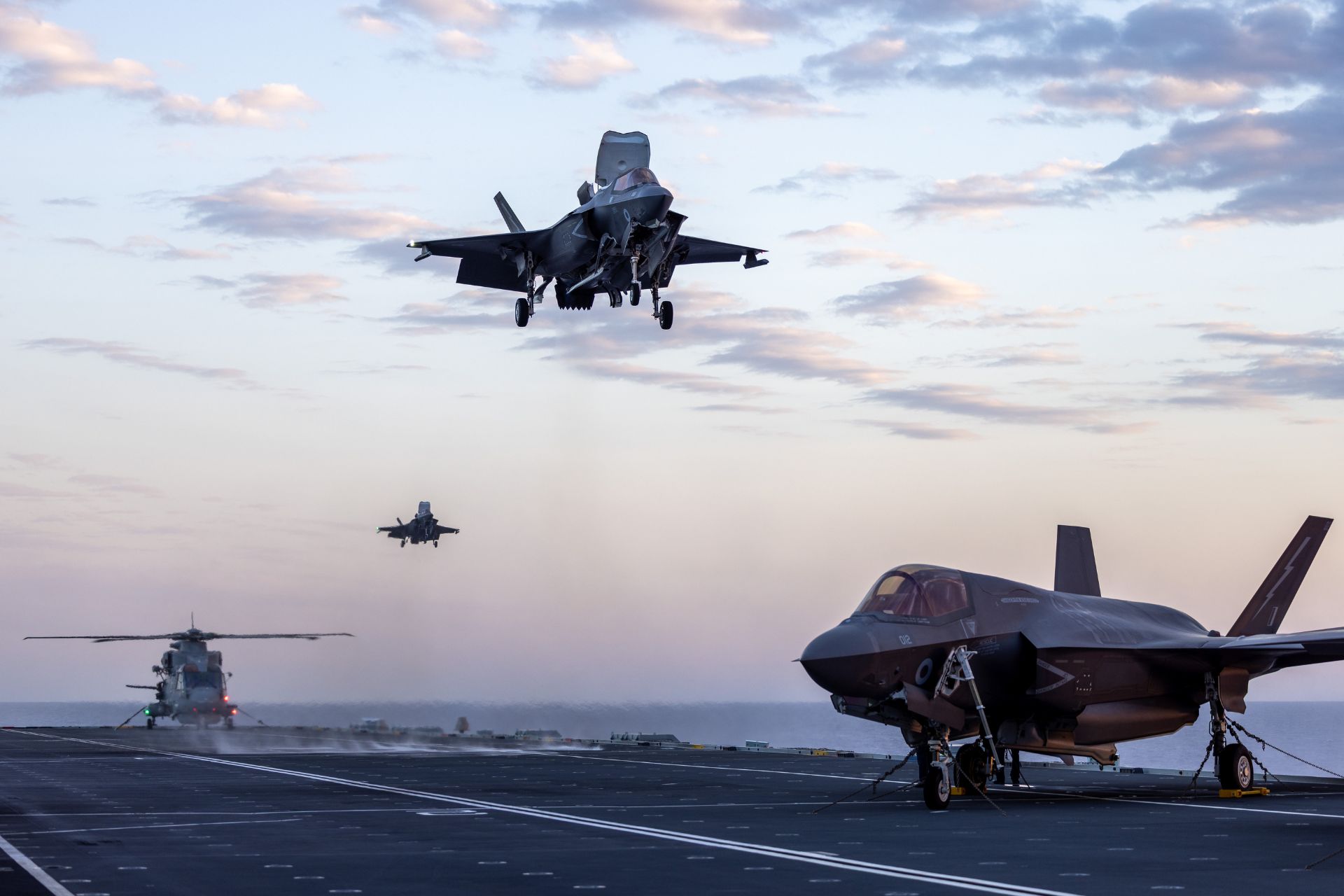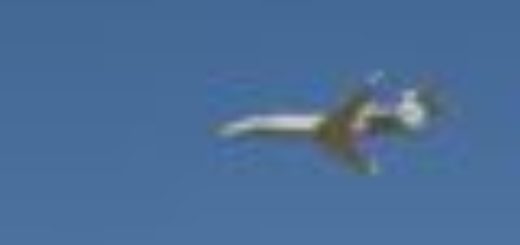UK Resumes F-35B Fighters Deliveries with Upgraded Weapons and Enhanced Computing Systems

{loadposition bannertop}
{loadposition sidebarpub}
After more than a year of interruption, the United Kingdom has resumed deliveries of its F-35B Lightning II fighter jets with the arrival, on May 8, 2025, of two new aircraft from Lockheed Martin’s production facility in Fort Worth, Texas. Designated 037/ZM171 and 038/ZM172, they arrived at Royal Air Force (RAF) Marham following a transatlantic flight supported by an Airbus Voyager tanker from RAF Brize Norton. These are the first jets delivered to the UK in the TR-3 configuration, marking a tangible and strategic step forward in the country’s F-35B acquisition programme.
Follow Army Recognition on Google News at this link
F-35B Lightning jets land back on HMS Prince of Wales after Ex MEDSTRIKE sortie (Picture source: UK MoD)
The F-35B Lightning II, designed for short take-off and vertical landing (STOVL) operations, remains the only platform combining this capability with stealth and supersonic speed. Operated by the US Marine Corps, the Royal Navy, the Royal Air Force, and the Italian Navy, it is capable of operating from aircraft carriers, roads, and austere airstrips. The TR-3 version features a new computing architecture designed to support the forthcoming Block 4 standard. This upgrade will enable the integration of enhanced sensors, improved data fusion, expanded electronic warfare capabilities, and increased interoperability with other air, land, and naval platforms.
In terms of capabilities, the F-35B TR-3 includes a reconfigurable internal weapons bay capable of carrying both air-to-air and air-to-ground munitions, and it can carry up to 6,800 kg of ordnance on external pylons when stealth is not required. It will eventually be compatible with MBDA’s Meteor missile, offering a range of over 200 km for beyond-visual-range engagements, and the SPEAR 3 munition, capable of accurately striking moving targets over 140 km away in contested environments. Equipped with the AN/APG-81 AESA radar, the Distributed Aperture System (DAS), and the AN/ASQ-239 electronic warfare suite, the aircraft ensures strong situational awareness and survivability against modern threats.
This delivery follows significant delays in the international F-35 programme, which had halted production and postponed aircraft handovers. The last F-35B delivered to the UK dated back to March 20, 2024, and was still built to the TR-2 standard. Transitioning to TR-3 now enables the progression toward Block 4 capabilities, a crucial development for the UK in aligning its air combat forces with the requirements of high-intensity operational environments.
With the arrival of these two aircraft, the UK’s total number of delivered F-35Bs stands at 38. However, following the loss of one aircraft in 2021 and the presence of four jets with the 17 Test and Evaluation Squadron (TES) in the United States, the number of F-35Bs currently available in the UK is 33. The initial contract for 48 aircraft is expected to be completed by the end of 2025. A second tranche of 27 additional aircraft has already been planned, bringing the total projected fleet to 75 by the early 2030s, including a replacement for the lost aircraft.
The F-35B remains a central component of the UK’s deterrence and power projection strategy. Operated jointly by the Royal Navy and the Royal Air Force, it is routinely deployed aboard the aircraft carriers HMS Queen Elizabeth and HMS Prince of Wales, forming the backbone of the UK’s Carrier Strike Group. However, this reliance on a system designed and controlled by the United States raises concerns. The aircraft’s software remains under the control of Lockheed Martin and cannot be independently modified by the UK, limiting London’s technological autonomy. In a context where transatlantic relations have become less predictable, particularly following recent decisions by the Trump administration regarding military aid to Ukraine, this dependency is increasingly questioned within British strategic circles.
The resumption of F-35B deliveries in the TR-3 standard, therefore represents a significant step for British forces, providing access to a modernized platform compatible with future Block 4 capabilities. However, it also highlights ongoing challenges related to technological sovereignty and industrial dependence on the United States. As Europe accelerates the development of its next-generation air defence programmes, the issue of balancing strategic cooperation with operational autonomy remains a key consideration for the United Kingdom.

{loadposition bannertop}
{loadposition sidebarpub}
After more than a year of interruption, the United Kingdom has resumed deliveries of its F-35B Lightning II fighter jets with the arrival, on May 8, 2025, of two new aircraft from Lockheed Martin’s production facility in Fort Worth, Texas. Designated 037/ZM171 and 038/ZM172, they arrived at Royal Air Force (RAF) Marham following a transatlantic flight supported by an Airbus Voyager tanker from RAF Brize Norton. These are the first jets delivered to the UK in the TR-3 configuration, marking a tangible and strategic step forward in the country’s F-35B acquisition programme.
F-35B Lightning jets land back on HMS Prince of Wales after Ex MEDSTRIKE sortie (Picture source: UK MoD)
The F-35B Lightning II, designed for short take-off and vertical landing (STOVL) operations, remains the only platform combining this capability with stealth and supersonic speed. Operated by the US Marine Corps, the Royal Navy, the Royal Air Force, and the Italian Navy, it is capable of operating from aircraft carriers, roads, and austere airstrips. The TR-3 version features a new computing architecture designed to support the forthcoming Block 4 standard. This upgrade will enable the integration of enhanced sensors, improved data fusion, expanded electronic warfare capabilities, and increased interoperability with other air, land, and naval platforms.
In terms of capabilities, the F-35B TR-3 includes a reconfigurable internal weapons bay capable of carrying both air-to-air and air-to-ground munitions, and it can carry up to 6,800 kg of ordnance on external pylons when stealth is not required. It will eventually be compatible with MBDA’s Meteor missile, offering a range of over 200 km for beyond-visual-range engagements, and the SPEAR 3 munition, capable of accurately striking moving targets over 140 km away in contested environments. Equipped with the AN/APG-81 AESA radar, the Distributed Aperture System (DAS), and the AN/ASQ-239 electronic warfare suite, the aircraft ensures strong situational awareness and survivability against modern threats.
This delivery follows significant delays in the international F-35 programme, which had halted production and postponed aircraft handovers. The last F-35B delivered to the UK dated back to March 20, 2024, and was still built to the TR-2 standard. Transitioning to TR-3 now enables the progression toward Block 4 capabilities, a crucial development for the UK in aligning its air combat forces with the requirements of high-intensity operational environments.
With the arrival of these two aircraft, the UK’s total number of delivered F-35Bs stands at 38. However, following the loss of one aircraft in 2021 and the presence of four jets with the 17 Test and Evaluation Squadron (TES) in the United States, the number of F-35Bs currently available in the UK is 33. The initial contract for 48 aircraft is expected to be completed by the end of 2025. A second tranche of 27 additional aircraft has already been planned, bringing the total projected fleet to 75 by the early 2030s, including a replacement for the lost aircraft.
The F-35B remains a central component of the UK’s deterrence and power projection strategy. Operated jointly by the Royal Navy and the Royal Air Force, it is routinely deployed aboard the aircraft carriers HMS Queen Elizabeth and HMS Prince of Wales, forming the backbone of the UK’s Carrier Strike Group. However, this reliance on a system designed and controlled by the United States raises concerns. The aircraft’s software remains under the control of Lockheed Martin and cannot be independently modified by the UK, limiting London’s technological autonomy. In a context where transatlantic relations have become less predictable, particularly following recent decisions by the Trump administration regarding military aid to Ukraine, this dependency is increasingly questioned within British strategic circles.
The resumption of F-35B deliveries in the TR-3 standard, therefore represents a significant step for British forces, providing access to a modernized platform compatible with future Block 4 capabilities. However, it also highlights ongoing challenges related to technological sovereignty and industrial dependence on the United States. As Europe accelerates the development of its next-generation air defence programmes, the issue of balancing strategic cooperation with operational autonomy remains a key consideration for the United Kingdom.






